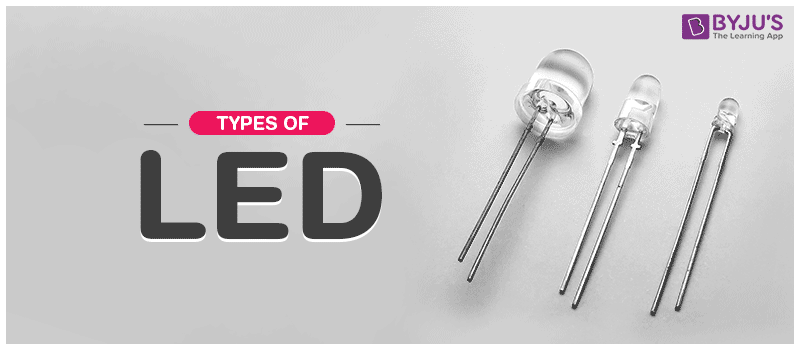Introduction:
LED (light-emitting diode) is a semiconductor light source that emits light when current flows through it. Their various types of LED are made of semiconductors and are classified into different categories. It is used due to its effectiveness in terms of lower power consumption, longer service life, better illumination.
LEDs are very widely used in today’s electronics equipment, and they are one of the major display technologies in use today. There are various types of LEDs which are discussed in the points below.

Classification of LED-based on sizes:
- Miniature
- Low-current
- Standard
- Ultra-high output
Classification of LED-based on power delivered:
- High-Power
Classification of LED-based on their application:
- Flash
- Bi and Tri-Colour
- RGB LEDs
- Alphanumeric
- Lighting LEDs
Different Types of LED (Light-Emitting Diode)
Miniature LEDs
- These are mostly used now these days. These are available in single shape and colour and are available in small sizes. It can be directly placed into a circuit board without the use of a heating or cooling device.
- These are classified into low-current, standard and ultra-high output depending upon various factors such as voltage, total watts, current, and manufacturer type.
- Miniature LEDs are used in small appliances such as remote controls, calculators and cell phones.
High-Power LEDs
- These uses of LED results in high output compared to normal LEDs. The light emitted is measured in terms of lumens. These are again categorised based on luminous intensity, wavelength and voltage.
- These have a danger of overheating hence a heat-absorbing material is used to cool it down.
- High-Power LEDs are used in high-powered lamps, automobile headlights, in various industrial and mechanical equipment.
Flash LED
With a normal LED, it contains an integrated circuit which flashes the light at a particular frequency. These are directly connected to a power supply without the help of series resistors. It is used in signboards, vehicles etc.
Bi and Tri-Colour
- Bi-colour LED lights consist of two light-emitting dies in a single case. The wiring is inversely parallel which means one is in the forward direction and another in backward which makes one die lit at one time. The flow of current alternates between two dies which results in colour variation.
- Tri-Colour LED lights design lets the two dies to lit separately or together producing a third colour.
Red Green Blue LEDs
These emit red, green and blue light and also allows to combine these three primary colours and produce a new colour. These are used in accent lighting, lights shows and status indicators.
Alphanumeric LED
- These consists of segments which offer greater flexibility and lesser power consumption. In it, it has various types of LEDs such as:
- 14 and 16 segment- they cover full 26 characters of the Roman alphabet in uppercase and with numerals 0-9
- 7 segment- covers all numbers and limited set of letters
- Matrix segment- covers full alphabets (upper and lower), all number and a full variety of symbols.
Lighting LED
These LEDs use aluminium/ceramic body which provides heat dissipation. One example is the Edison light bulb design.
Does light behave like a wave?

Frequently Asked Questions – FAQs
What is a diode?
A diode is an electrical device that allows the current to flow only in one direction. In a circuit figure, a diode is denoted by a triangle with a straight line across one vertex.
What is the full form of the LED?
LED stands for Light Emitting Diode.
Explain the characteristics of an LED.
LED is a semiconductor light source that produces light when electric current flows through the diode. These diodes are widely used due to their effectiveness in terms of low power consumption, longer shelf life, and better illumination. There are various types of LEDs made and are classified into different categories.
What are the main types of LEDs based on current outputs?
Low-current LED, standard LED, and ultra-high-output LED are the main types of LEDs based on current outputs.
What are the uses of miniature LEDs?
Miniature LEDs are typically used in small electronic appliances such as calculators, cell phones, and remote controllers.
What is a Bi-colour LED?
Bi-colour LED lights are made of two light-emitting diodes in a single case. The wiring is inversely parallel, where one is in the forward orientation and another in backward, which makes one diode lit at one time. The current flow alternates between the two diodes, which results in colour change.

Comments